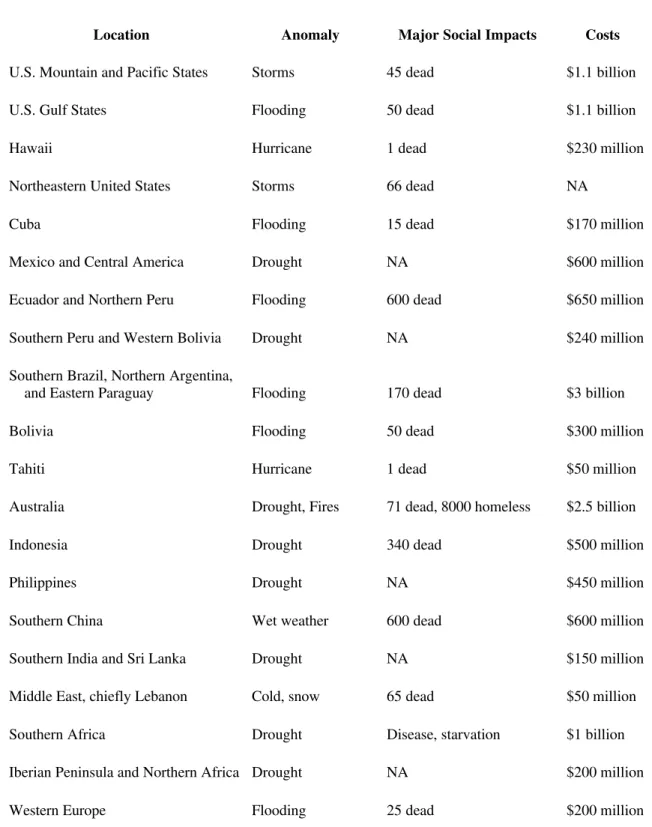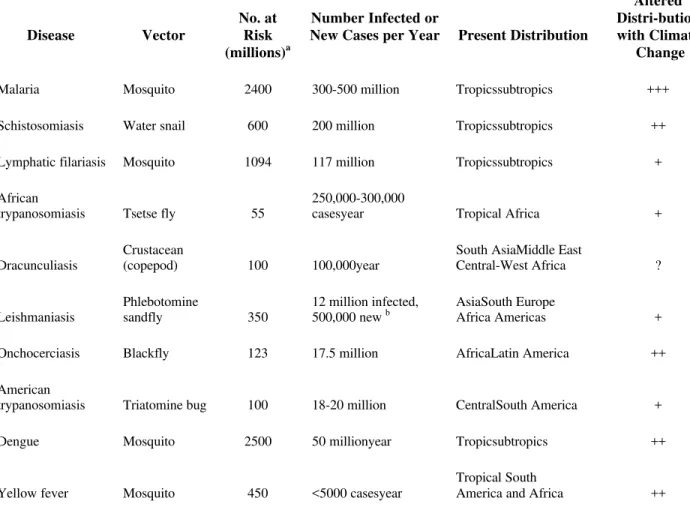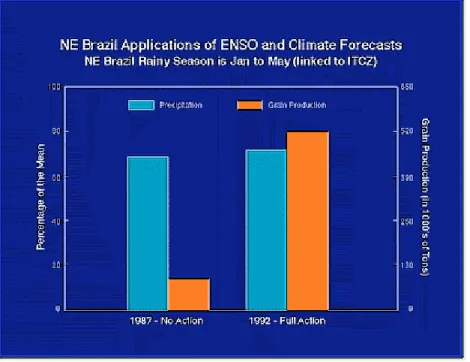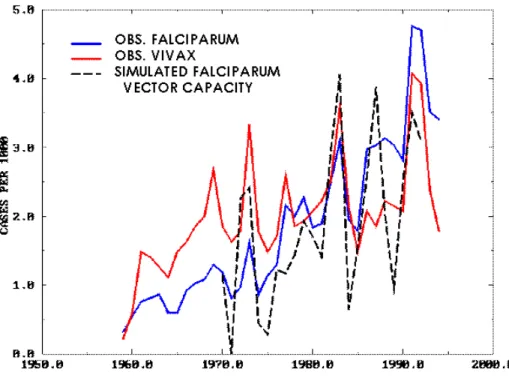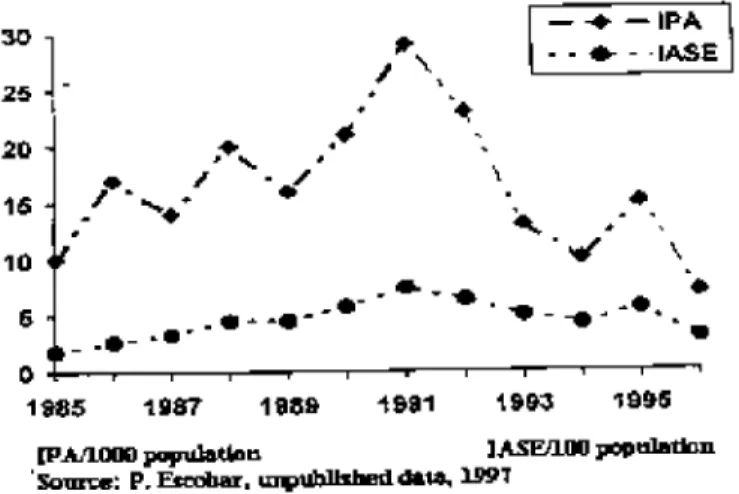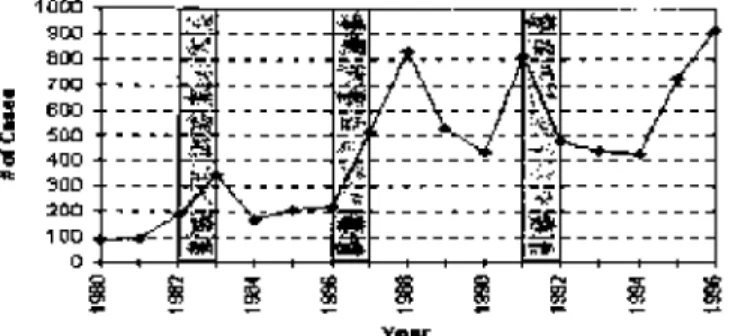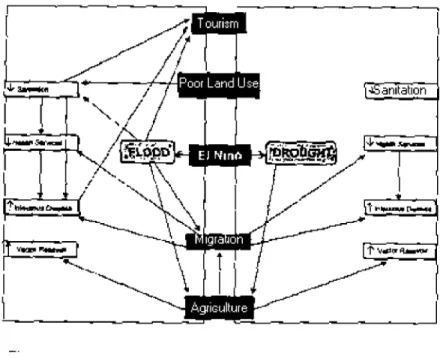PAN AMERICAN HEALTH ORGANIZATION WORLD HEALTH ORGANIZATION
SUBCOMMITTEE ON PLANNING AND PROGRAMMING
OF THE EXECUTIVE COMMITTEE
30th Session, 30-31 March 1998
Provisional Agenda Item 5 SPP305 (Eng.)
9 February 1998
ORIGINAL: ENGLISH
CLIMATE CHANGE AND INFECTIOUS DISEASES:
THE IMPLICATIONS OF EL NIÑO
CONTENTS
EXECUTIVE SUMMARY 3
1. Introduction 4
1.1 El Niño and the Southern Oscillation 6
1.2 Forecasting El Niño 6
1.3 El Niño in the Americas 7
1.4 Infectious Disease Impacts 8
2. Disease Transmission in the Americas 12
2.1 Malaria 12
2.2 Dengue and Other Diseases Caused by Arboviruses 13
2.3 Viral Encephalitides 16
2.4 Waterborne Diseases 16
2.5 Hantavirus Pulmonary Syndrome and Other Rodent-associated Diseases 17
3. Conclusion 17
EXECUTIVE SUMMARY
El Niño is a natural phenomenon that causes anomalies in normal patterns of rainfall and temperature. Compared with other climate changes, El Niño events are notable for their wide geographic influence and the long duration of their extremes. The fact that El Niño events are extended climate events with large-scale effects makes them extremely important to the public health sector. The ability to project future El Niño events gives the public health sector the opportunity to prepare for and to better control transmission of disease.
At present, there are no concrete data that demonstrate that an increase or decrease in infectious diseases is consistently and reliably related to El Niño events. However, some associations from retrospective studies and preliminary data from ongoing studies suggest that El Niño events have an impact on the incidence of certain infectious diseases. The consequence of El Niño’s impact on disease transmission should be considered within the context of disease ecology (epidemiological endemic levels, existing vector reservoirs, hostparasite interactions, etc.), the severity of the El Niño event, other climatic influences, and social change. The relationship between El Niño and health is complex.
For example, waterborne diseases such as leptospirosis and diarrheal infections increase during heavy rains. Thus, to the extent that an El Niño event causes heavy rains, El Niño may increase the risk of waterborne diseases. However, extreme weather events can also occur in non-El Niño years and cause outbreaks of infectious diseases, such as the outbreak of leptospirosis in Nicaragua in 1995. Alternately, some effects of El Niño may be beneficial. In 1997, the malaria incidences in Iquitos, Peru, and in Boa Vista, Brazil, decreased during an El Niño-related drought.
There is a need to develop a scientific agenda that will examine the impact of extreme events such as El NiñoSouthern Oscillation (ENSO) on human and animal health. Attention should be paid to the vulnerability of ecosystems to ENSO, how disease incidence will respond to extreme climatic events, and how health programs will adjust to climate-induced changes in morbidity and mortality.
1. Introduction
The 40th Directing Council of the Pan American Health Organization (1997) adopted Resolution CD40.R13, “Health Emergency Preparedness for Disasters Caused by El Niño,” in which it resolves:
1.To urge countries affected by “El Niño” that have not already done so to update their contingency plans to provide an adequate response to the health problems arising from this phenomenon.
2.To request the Member States to:
(a) take the necessary steps to develop effective coordination among sectors and mutual cooperation among countries in the spirit of regional integration;
(b) strengthen and integrate their systems for early warning, epidemiological surveillance, and the control of communicable diseases, particularly water-borne and vector-borne diseases, and disseminate this information freely through the Internet and other modern means of communication.
3.To request the Director to:
(a) strengthen technical cooperation with the Member States for emergency preparedness to enable them to deal with any emergency or disaster caused by “El Niño,“ coordinating actions in the health sector with subregional institutions such as the Hipólito Unanúe Agreement and with other multisectoral institutions;
(b) ensure that the priorities of this cooperation are focused on analyzing epidemiological risk, coordinating the preparation of contingency plans, integrating responses among the countries, exchanging information for decision-making and public awareness, and training both medical and public health personnel.
There is growing concern that climate change will have broad and long-term impacts on health. Various scenarios and models have been used to project what would happen in the future if global warming continues and anthropogenic changes in the landscape increase. It is generally concluded that climate warming will greatly disrupt natural systems and increase environmental health risks (7). The long-term impacts on health could be drastic and irreversible.
Examples of observed climate changes include an increase in global temperatures ranging from 0.3º C to 0.6º C, a diurnal temperature range decrease, the global retreat of major glaciers, and an increase or decrease in precipitation in certain regions of the world (8).
Public interest and concern over El Niño is increasing. Traditionally, meteorological changes and environmental impacts of the phenomenon have been the focus of ENSO-related press. Since the severe ENSO event of 1982-1983, major social and economic consequences have been reported as additional effects of the phenomenon. Table 1 reflects significant concern following the ENSO event of 1982-1983.
Table 1. Effects of the 1982-1983 ENSO (in US$)
Location Anomaly Major Social Impacts Costs
U.S. Mountain and Pacific States Storms 45 dead $1.1 billion
U.S. Gulf States Flooding 50 dead $1.1 billion
Hawaii Hurricane 1 dead $230 million
Northeastern United States Storms 66 dead NA
Cuba Flooding 15 dead $170 million
Mexico and Central America Drought NA $600 million
Ecuador and Northern Peru Flooding 600 dead $650 million
Southern Peru and Western Bolivia Drought NA $240 million
Southern Brazil, Northern Argentina,
and Eastern Paraguay Flooding 170 dead $3 billion
Bolivia Flooding 50 dead $300 million
Tahiti Hurricane 1 dead $50 million
Australia Drought, Fires 71 dead, 8000 homeless $2.5 billion
Indonesia Drought 340 dead $500 million
Philippines Drought NA $450 million
Southern China Wet weather 600 dead $600 million
Southern India and Sri Lanka Drought NA $150 million
Middle East, chiefly Lebanon Cold, snow 65 dead $50 million
Southern Africa Drought Disease, starvation $1 billion
Iberian Peninsula and Northern Africa Drought NA $200 million
Source: New York Times, 2 August 1983
As El Niño continues to receive greater attention, public demand for understanding it grows. El Niño is second only to seasonal changes in its impact on world climate. This paper reviews what is known about El Niño and health, explores the health impact of El Niño and the Southern Oscillation, and then discusses the steps PAHO can take to assist Member States as they confront the problems of changing climate and El Niño.
1.1 El Niño and the Southern Oscillation
In the 1920s, Sir Gilbert Walker observed a “seesaw” relationship among barometric pressures in the southern Pacific Ocean—when the pressure was high in the western Pacific, it was low in the eastern Pacific, and vice versa, causing dramatic shifts in surface wind direction and velocity. He named the occurrence the Southern Oscillation. Later, as other scientists learned more about wind patterns and ocean temperatures in that region, they were able to link Walker’s pressure seesaw with the periodic strong, warm ocean current along the coasts of Peru and Ecuador known as El Niño. More importantly, they discovered that El Niño and the Southern Oscillation—collectively known as ENSO—were a weather phenomenon responsible for monsoon rains, droughts, and other climatic changes across much of the globe, including the equatorial Pacific, the United States, Canada, Latin America, and Africa.
During an El Niño event, rain falls in the eastern Pacific while the western Pacific is dry. Normally, monsoons occur in the western Pacific while the eastern Pacific is dry. Unlike annual weather patterns, which are predictable, El Niño events reoccur at irregular intervals every 2-7 years and are never the same (Table 2). They typically begin around Christmas and last 12-18 months. The most severe ENSO event recorded was in 1982-1983. Since then another occurred in 1986-1987 and there was an extended ENSO event from 1990-1995. We are presently undergoing an ENSO event that is expected to last into 1998.
The sister of El Niño, La Niña, is the cold phase of ENSO and describes the situation when there are cold eastern and central equatorial Pacific sea surface temperatures. In the western Pacific, a La Niña event increases precipitation.
1.2 Forecasting El Niño
There has been considerable progress in forecasting ENSO events. Atmosphere-ocean forecast models have been developed which can predict El Niño from four months to a year in advance. The warming of the surface of the sea in the tropical Pacific was predicted one year before the ENSO phenomenon of 1986-1987. The ability to reliably link sea surface temperature data with
Table 2. El Niño and La Niña Years (generally from October to September)
El-Niño Years La Niña Years
1900-1901 1903-1904
1902-1903 1906-1907
1905-1906 1908-1909
1911-1912 1916-1917
1914-1915 1920-1921
1918-1919 1924-1925
1923-1924 1928-1929
1925-1926 1931-1932
1930-1931 1938-1939
1932-1933 1942-1943
1939-1940 1949-1950
1940-1941 1954-1955
1941-1942 1964-1965
1946-1947 1970-1971
1951-1952 1973-1974
1953-1954 1975-1976
1957-1958 1988-1989
1963-1964
1965-1966
1969-1970
1972-1973
1976-1977
1982-1983
1986-1987
1991-1992
1993-1994
At present, climate forecasts related to upcoming rainy seasons (on the pacific coast of South America) are based on the wind and water temperatures in the tropical Pacific region and the output of numerical prediction models. Four forecast possibilities exist: (1) near normal conditions; (2) a weak El Niño with slightly wetter than normal growing seasons; (3) a full-blown El Niño with flooding; or (4) cooler than normal waters offshore, with higher than normal chance of drought (13).
1.3 El Niño in the Americas
In the Americas there are several general changes in precipitation patterns associated with ENSO events (15). In North America there is generally greater than normal precipitation in the Gulf and northern Mexico regions from October to March (Figure 1). In the Great Basin of the United States there is greater than normal precipitation from April to October.
Figure 1. Potential Impacts of El Niño on Mexico and on Central and South America
Source: NOAA 1997
In the northeast region of South America (north equatorial Brazil, French Guiana, Guyana, Suriname, and Venezuela) there is less precipitation from July to March. In southeastern South America (southern Brazil, Uruguay, and parts of northeastern Argentina), there is greater than normal precipitation from November to February (Figure 1).
The Pacific coast of South America in Ecuador and Peru also has greater than normal precipitation during El Niño years.
In the Amazon region low rainfall does not coincide with ENSO events but lags one year behind (4). However, because there is a lack of long-term precipitation data from this region and the region has complex rainfall regimes, it is hard to construct a regional index for the entire basin (4). In other words, less than normal precipitation would more than likely occur, but precipitation extremes are not as highly correlated with ENSO as are other parts of South America.
The Andean region is also affected by ENSO. There is, however, insufficient information available to make generalizations. It is assumed that the impact of El Niño on precipitation extremes is less in the Andean region than in other regions.
In all regions, the specific timing and duration of the climatic effects associated with an El Niño event may vary, depending on such factors as the season of onset (e.g., the 1997 El Niño began in May-June, which is much earlier than usual). Within this overall picture El Niño exhibits different strengths and patterns in specific localities. Thus, disease patterns may vary within an El Niño-affected area.
1.4 Infectious Disease Impacts
ENSO events cause extremes in precipitation, temperature, and humidity and it is known that these climatic factors can be detrimental (or beneficial) to health. In Table 3, WHO has reviewed the potential impact of climate change (both anthropogenic and natural) on health (18). Vectorborne diseases are a major concern in the Americas and the possible impact of climate change and El Niño events has also been reviewed in 1996 by WHO (Table 4). These scenarios are based on historical events, generalized climatic models, and information on disease transmission.
Following an El Niño event, the potential risk of communicable disease is influenced not only by changes in the environment, but also by changes in population density, disruption of public utilities, and interruption of public health services. It should also be noted that the risk of communicable disease following an El Niño event is related to the endemic level of the disease in the community; therefore, little risk exists of a given disease if the causative organism is not present beforehand (14). This underscores the need for an effective disease surveillance program prior to an El Niño event.
Table 3. Likely Relative Impact on Health Outcomes of the Components of Climate Change
Aspects of Climate Change
Change in Mean Extreme Events Rate of Change of Day-Night
Health outcome Temperature, etc. Climate Variable Difference
Heat-related deaths and illness +++ +
Physical and psychological trauma
due to disasters ++++
Vectorborne diseases +++ ++ + ++
Non-vectorborne infectious diseases + +
Food availability and hunger ++ + ++
Consequences of sea level rise ++ ++ +
Respiratory effects:
− air pollutants + ++ +
− pollens, humidity ++
Population displacement ++ + +
Table 4. Major Tropical Vector-Borne Diseases and the Likelihood of Change in Their Distribution as a Result of Climate Change
Likelihood of Altered No. at Number Infected or Distri-bution Disease Vector Risk New Cases per Year Present Distribution with Climate
(millions)a Change
Malaria Mosquito 2400 300-500 million Tropicssubtropics +++
Schistosomiasis Water snail 600 200 million Tropicssubtropics ++
Lymphatic filariasis Mosquito 1094 117 million Tropicssubtropics +
African 250,000-300,000
trypanosomiasis Tsetse fly 55 casesyear Tropical Africa +
Crustacean South AsiaMiddle East
Dracunculiasis (copepod) 100 100,000year Central-West Africa ?
Phlebotomine 12 million infected, AsiaSouth Europe
Leishmaniasis sandfly 350 500,000 new b Africa Americas +
Onchocerciasis Blackfly 123 17.5 million AfricaLatin America ++
American
trypanosomiasis Triatomine bug 100 18-20 million CentralSouth America +
Dengue Mosquito 2500 50 millionyear Tropicsubtropics ++
Tropical South
Yellow fever Mosquito 450 <5000 casesyear America and Africa ++
+= likely; ++= very likely; +++= highly likely; ?=unknown
a Top 3 entries are population-pro-rated projections, based on 1989 estimates.
b Annual incidence of visceral leishmaniasis; annual incidence of cutaneous leishmaniasis is 1-1.5 million cases per year.
Source: WHO, 1996
Figure 2. Impact of El Niño Prediction on Brazil Crop Yields
Source: NOAA 1997
At present we have a general idea of where and when weather extremes caused by El Niño events will occur. Therefore, we can determine the regions of highest vulnerability and of greatest epidemic risk, and begin to incorporate climate change into existing health programs. As better predictive models become available they can be updated and should be used.
It has been argued that El Niño and climate change will influence the distribution and intensity of infectious diseases in the Americas (2). To date there is little definitive data, which directly links El Niño to infectious disease transmission. The consequence of El Niño’s impact on disease transmission, however, has to be considered within the context of disease ecology, the degree of the El Niño event anomalies, and social change.
2. Disease Transmission in the Americas
To underscore the dilemma in linking El Niño events to health, data on several of the most important communicable infectious diseases in the Americas are presented below.
2.1 Malaria
Recent studies have implied that increases in temperature, humidity, and precipitation have contributed to the increase in malaria transmission (1, 3). In addition, global climate models have been used to analyze scenarios of climate change and malaria transmission (11). The results of these models predict a global increase in malaria.
El Niño is a component of climate change that contributes to extremes in weather conditions over short periods of time (seasonal and annual cycles). The increases in temperature and precipitation during El Niño have been suggested as the potential causes of malaria epidemics. In Colombia, it has been suggested that increases in malaria cases over the last three decades correlated with the El Niño events of 1972-1973, 1982-1983, 1986-1987, and 1992-1993 (Figure 3).
However, other malaria prevalence data from Colombia indicate that a definitive conclusion is not possible. The impact, if any, of El Niño on malaria in Colombia appears to be localized. For example, in the province of Antioquia, Colombia, the annual parasitic indices actually decreased from 1991 to 1996 during the apparently continuous ENSO 1990-1995 event (Figure 4). The contradiction in results may be due to differences in vector species andor parasites. A vector’s response to changes in climate extremes is species-dependent and cannot be generalized for all species. Control measures also impact the number of malaria cases, which vary from one locality to another.
Figure 3. Malaria in Colombia
Source: International Research Institute for Climate Change, 1997
Other factors such as forced migration of non-immune populations (caused by flooding, drought, war, etc.) into areas of endemic malaria may provoke malaria outbreaks. For example, data from Pakistan (3) shows a positive correlation between malaria and temperature, but the data is confounded by the fact that mass emigration of refugees from Afghanistan into Pakistan occurred during the earlier years of the malaria increase.
It appears that human or environmental factors confound any scientific analysis that could directly link El Niño or climate changes with malaria incidences. If El Niño events do contribute to changes in malaria incidences, it is extremely difficult to separate their effect from other factors that impact malaria transmission.
2.2 Dengue and Other Diseases Caused by Arboviruses
and concluded that an increase in temperature of 20 C would increase the latitudinal and altitudinal range of dengue and extend the duration of the transmission season. However, as with malaria, it is difficult to prove with scientific data that the change in distribution of dengue is the result of climate change or El Niño events. In a preliminary study that intended to correlate dengue with increased rainfall, there was no positive correlation between the two factors. In fact, peaks in dengue did not occur in El Niño years.
Figure 4. Annual Parasitic Indices (IPA) for Antioquia Province, Colombia
Figure 5
2.3 Viral Encephalitides
Arboviruses like Japanese, Eastern, and Murray Valley encephalitis are known to cause severe epidemics after periods of heavy rains. El Niño events have been suggested as the cause of recent outbreaks of Murray Valley encephalitis in Australia, and La Niña events as the cause of an epidemic of Japanese encephalitis in India (12). Riesen showed in a series of studies that an increase in temperature would decrease mosquito survival but increase mosquito growth rate virus-extrinsic incubation, and extend the timeframe when virus transmission would occur. However, an absence of scientific data on viral encephalitides still exists and a correlation of El Niño or La Niña with outbreaks of arboviruses cannot be supported by current data.
2.4 Waterborne Diseases
It is extremely difficult to quantify the relationship between human health, climate change, and waterborne disease (18). In Brazil, Sp. leptosporosis is more likely to occur during periods of high precipitation (10). It is well known that El Niño in southern Brazil causes an increase in rainfall (Figure 1). However, when cases of leptospirosis are compared with El Niño years there appears to be no correlation (Figure 6), and it appears that sudden intense rainfall is the key factor, which triggers an increase in leptospirosis. For example, during the epidemic of leptospirosis in Nicaragua in 1995, a non-El Niño year, the rainfall in the municipalities affected by this epidemic was the greatest amount recorded in the last 35 years (>3,500 mm). This suggests that historical rainfall data needs to be taken into account when measuring the parameters that cause outbreaks of leptospirosis and other waterborne diseases. Such measurements should be taken in areas where flooding occurs, where wastewater mixes with drinking water, and where people come into contact with contaminated water or rodents.
Figure 6. Cases of leptsospirosis in Sao Paulo, Brazil from 1980-1996
Recently, it has been proposed that higher than normal temperatures in 1997 caused by El Niño increased the number of diarrhea cases in Lima, Peru (16). Unfortunately, no data on diarrhea during any other El Niño phenomenon was presented for comparison.
Cholera outbreaks have been associated with precipitation extremes—both droughts and floods (18). It has been thought that various components of climate change—such as rising temperatures, changing precipitation patterns, uncertainty of storm frequency, and floods—have caused cholera outbreaks. More recently it was discovered that Vibrio cholerae is associated with a large range of marine life located on the surface of the water (5). Under adverse conditions,
V. cholerae enters a non-active state on these organisms; when conditions of nitrogen, phosphorus, and warming are favorable, V. cholerae reverts to a cultivable and infectious state. It has been suggested that the 1991 El Niño event, which warmed the ocean along the coast of Peru and Ecuador, accelerated the outbreak of cholera in this region (5). However, the quality of the watersanitation system as a possible cause of the outbreak and its eventual spread has not been adequately investigated. The possible interplay between the marine environment and sanitation systems in fostering the spread of cholera should also be considered.
2.5 Hantavirus Pulmonary Syndrome and Other Rodent-associated Diseases
The emergences of new viruses including Hantavirus and Sin Nombre virus have caused severe health and economic impacts. The impact of El Niño events on the emergence of these diseases is not well known. It has been suggested that prolonged drought conditions destabilize the predator-prey cycle, which controls rodents (6, 17). This causes an increase in rodent populations, which indirectly leads to an increase in human-rodent contact, thereby potentially increasing the risk of rodent-associated disease transmission.
Extreme climate events such as flooding can also increase rodent-human contact. The flooding of rodent burrows forces rodents to seek shelter in human dwellings. This provides the opportunity for increased human-rodent contact (6). The same scenario applies to the rodent population that causes plague.
The historic information on rodent-associated diseases and climate suggest that extreme climate events catalyze disease outbreaks. Nevertheless, it has yet to be shown that El Niño increases the risk of rodent-associated diseases.
3. Conclusion
Figure 7. Multisectorial Impact of El Niño
The projected impacts of El Niño on disease will vary with the manifestation of the phenomenon (flood, drought, temperature increase). Since El Niño serves to exacerbate conditions already present, the risk of communicable disease will increase in areas where the disease is already endemic. In preparation, countries should prepare a checklist (Table 5) to assess regional risk factors as well as continue effective disease surveillance in order to recognize changes in endemic disease levels related to the El Niño phenomenon. The incorporation of climate forecasting into existing disease surveillance, emergency preparedness, and prevention programs can help lessen the health impacts of El Niño, the Southern Oscillation, and other extreme events.
Table 5. Example of a Disease Checklist
Projected effects of El Nino on Disease
Flood Drought Temperature Increase
Water borne disease
Cholera ++++ +
Rotavirus ++++
Diarrhea non specific ++++
Viral hepatitis A ++ +
Dinoflagellates - - +++
Vector borne disease
Malaria + - +
Dengue + ?
Rabies ++ +
Physical and Chemical factors
Pesticides ++ -
-Toxic iron ores ++ -
-Respiratory disease - ++ +
++++ = extreme impact, '+++ = large impact, '++ = moderate impact, '+ = small impact
References
1. Attenborough RD, Burkot TR, and Gardner DS. 1997. Altitude and the Risk of Bites from Mosquitos Infected with Malaria and Filariasis among the Mianmin People of Papua New Guinea. Trans. Roy. Soc. Trop. Med. Hyg., 91:8-10.
2. Bouma MJ and Dye C. 1997. Cycles of Malaria Associated with El Niño in Venezuela.
JAMA, 278:1772-1774.
3. Bouma MJ, Dye C, and Van Der Kaay HJ. 1996. Falciparum Malaria and Climate in the Northwest Frontier Province of Pakistan. Am. J. Trop. Med. Hyg., 55:131-137.
4. Chu, Pao-Shin. 1991. Brazil’s Climate Anomalies and ENSO. In Teleconnections Linking Worldwide Climate Anomalies; pp.43-71. Scientific Basis and Societal Impact. Eds. MH Glantz, RW Katz, N Nicholls, Cambridge Univ., NY, 535pp.
5. Epstein PR, Ford TE and Colwell RR. 1994. Marine Ecosystems. Pp.14-17. In Health and Climate Change. Ed D Sharp, Lancet.
6. Epstein PR. 1995. Emerging Diseases and Ecosystem Instability: New Threats to Public Health. Am J. Public Health 85(2): 168-172.
7. EPA. Global Warming. Key Findings of the Second Assessment Report of the Intergovernmental Panel on Climate Change. 2 October 1997.
8. Jackson EK. 1995. Climate Change and Global Infectious Disease Threats. Med. J. Australia, 163:570-574.
9. Jetten T and Focks D. 1997. Potential Changes in the Distribution of Dengue Transmission under Climate Warming. Am. J. Trop. Med. Hyg., 57:285-97.
10. Fundacão Nacional da Saúde (FNS). 1997. A Leptospirose humana no Brasil nos anos 1985-1996. Informe final, 109pp.
11. Marten P. 1997. Health Impacts of Climate Change and Ozone Depletion: An Eco-epidemiological Modeling Approach. 158pp.
13. Nicholls N. 1994. El Niño-Southern Oscillation and Vectorborne Disease. pp.21-22. In Health and Climate Change. Ed. D. Sharp, Lancet.
14. NOAA, 1994. El Niño and Climate Change: Report to the Nation on Our Changing Planet. University Corporation for Atmospheric Research (UCAROIES) and NOAA.
15. PAHO, 1982. Epidemiologic Disease Surveillance after Disaster, Scientific Publication 420 pp.3-4; Emergency Vector Control after Natural Disaster, Scientific Publication 419.
17. Salazar-Lindo E, Pinell-Salles P, Maruy A, and Chea-Woo E. 1997. El Niño and Diarrhoea and Dehydration in Lima, Peru. Lancet, 350 (9091): 1597-1598.
18. Stone R. 1995. Global Warming. If the Mercury Soars, so May Health Hazards. News and Comments. Science. 267: 957–958.
